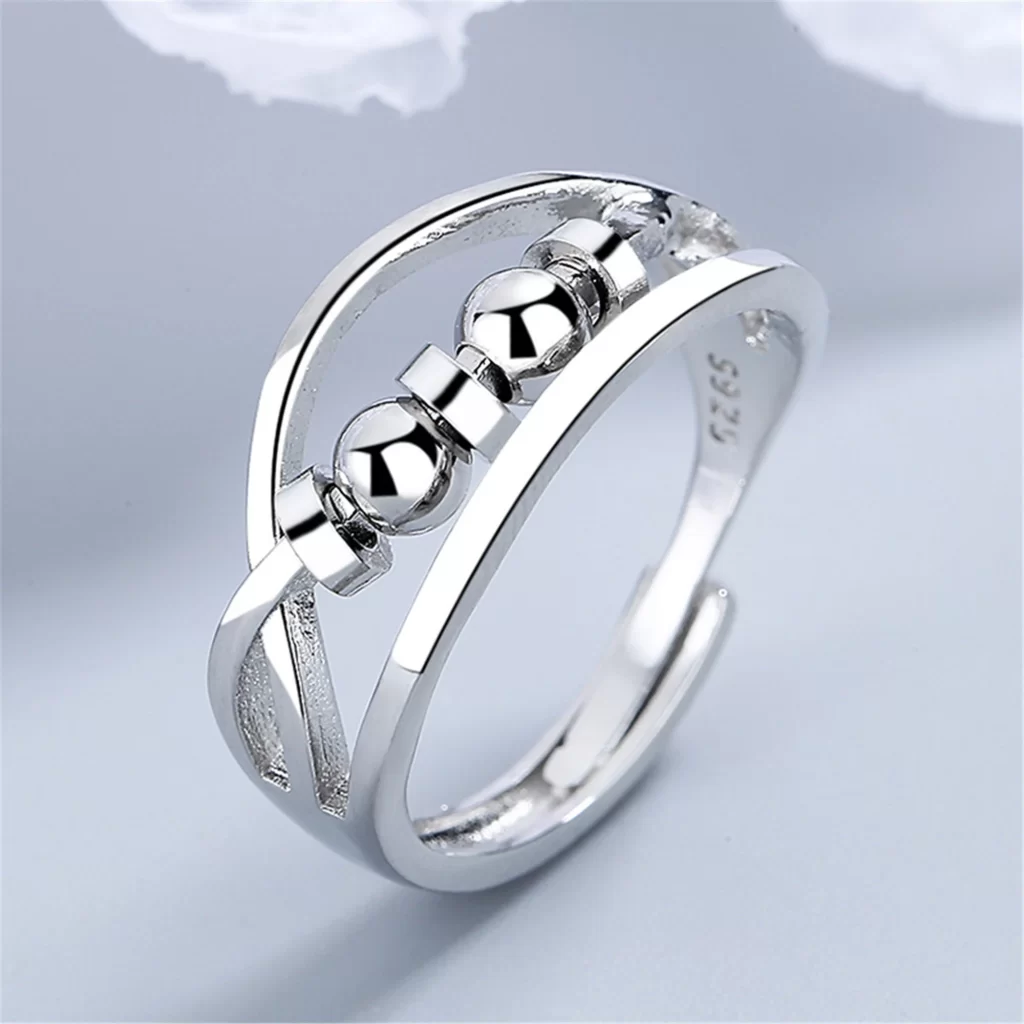I see a lot of stressed people in my hypnotherapy practice. The first session can be nerve-wracking for those who don’t know what to expect. And so, when they sit down, sitting still isn’t an option. Hair twiddling, toe-tapping, knee jiggling and hand wringing are all signs of the body releasing tension through repetitive movement. If they had anxiety rings or a necklace to fiddle with, they’d find it much easier to walk into the unknown.
School teachers know it’s pointless to ask a class of 30 children of any age to sit still. In fact, researchers have discovered that they may pay more attention if they’re allowed to fidget as this can calm anxiety and enable a busy brain to focus.
We all have little stress-busting routines and rituals which we’re mostly unaware of while we’re doing them. Tendencies to do things like chewing pen tops, fiddling with clothing or anything handy are common and normal comforting behaviours. Other anxiety related habits like nail biting or skin picking are embarrassing to adults as they’re regarded as being childish. There are many secret thumb-sucking adults who would be mortified if they were ever found out.

To fidget or not to fidget
Table of Contents
The line between fidgeting and hyperactivity or stress relieving habits and anxiety disorders is blurred. Nibbling on a hangnail is not the same as biting nails till they bleed. Twirling a strand of hair is very different to trichotillomania, a compulsive urge to pull hair out. Rapid, restless ‘psychomotor agitation’ is an extreme form of fidgeting that borders on self-harm when it involves scratching, biting, pinching or punching to cause pain.
A US study revealed that students playing with stress balls were less distracted during lessons and working independently. Kinesthetic learners, who absorb information through movement and touch, enjoyed increased attention spans. All students showed improvements in attitude, writing abilities, peer interactions, and achievements while manipulating stress balls.
Associated Disorders
Unconscious fidgeting is a classic symptom of ADHD and OCD sufferers tap or count to relieve anxiety. That doesn’t mean that everyone who fidgets has these issues. However, any degree of anxiety-induced behaviour patterns will only stop when the underlying cause has been identified and resolved. When I see children who can’t sit still, their parents will often chastise them as not moving is seen as ‘good’ behaviour even though it’s something children rarely do voluntarily unless they’re asleep. But I’m quite happy to let them fidget and wriggle as they will often pay more attention and be much calmer for doing so than their parents.
Tics are another form of fidgeting which is outside of conscious control and indicative of emotional stress. Trying to stop tics or fidgeting habits can aggravate them by drawing attention to an unconscious reaction. For example, if you tell a nail-biter to stop, they’ll often be surprised because they didn’t know they were doing it. And then, they’ll start again the moment their attention wanders.
Fidgeting is in the genes
Babies soothe with blankets and dummies, toddlers suck thumbs, chew sleeves and fiddle with fluffy bunny ears, children repetitiously bounce balls, snap rubber bands, ping rulers and flick paper. Mums sanitise everything, and Tom Daley knits. We never really stop fidgeting through our lifetimes.
The need for sensory stimulation is not new. Familiar and comforting fidget gadgets like prayer beads, rosaries, Tibetan spinning rings and weighted meditation balls have existed for centuries. Restlessness and hyper-vigilance is a physical response to a perceived threat which can be soothed by familiar rituals and routines. From an evolutionary perspective, fidgeting is a preparatory energy surge for the flight or fight response and has been crucial to our survival.
Anxiety rings, toys and trinkets
It’s now possible to indulge our restlessness with fidget spinners, pop-its, cubes and balls, putty and magnets. And the latest fad is fidget jewellery. Anxiety rings are designed to keep your mind calm and your hands busy. These pretty accessories come with multiple bands that spin or tiny beads that rotate. Fidgeting with anxiety rings can provide a distraction from unhealthy, anxious thoughts. In any situation, they are a discreet way of calming down without anyone noticing that you were stressed in the first place.
For children, there are primary coloured chewable necklaces. Anxiety-calming jewellery for men and women, adults and children includes bangles, rings and pendants. Just like essential oils, crystals and natural remedies, these are harmless devices that provide comfort by tapping into beliefs which provide a sense of control. Taking action is better than no action. Distraction diverts attention away from catastrophic thoughts or anticipatory anxiety.
Research has shown that fidgeting with things like anxiety rings lowers cortisol, the stress hormone, clears our heads, and improves memory by stimulating dopamine. Fidgeting with a handy, easily available object like a ring on your finger gives your brain something to focus on so that your nervous energy and thoughts are calmed. Some jewellery is designed to vibrate or hum to create a hypnotic effect and reduce overthinking.
When anxiety is overwhelming, playing with anxiety rings or other trinkets can help you redirect nervous energy. They can be used as part of a toolkit of techniques and strategies to alleviate anxiety. Meditation, breathwork, hypnotherapy and physical activity can help your mind slow down and focus. Self-care and a good support system of family and friends also reduces anxiety and its symptoms. Providing they can put up with your annoying knee-jiggling or finger-drumming tendencies.
